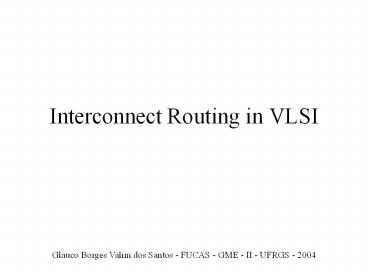Interconnect Routing in VLSI - PowerPoint PPT Presentation
Title:
Interconnect Routing in VLSI
Description:
Consider the logic gate schematic representation of an hypothetical circuit: ... gate and the inputs going into an inverter, a nor gate and another nand gate ... – PowerPoint PPT presentation
Number of Views:174
Avg rating:3.0/5.0
Title: Interconnect Routing in VLSI
1
Interconnect Routing in VLSI
Glauco Borges Valim dos Santos - FUCAS - GME - II
- UFRGS - 2004
2
Interconnect Routing is the task of making
electrically equivalent a set of points
concerning to gates inputs/outputs. Consider the
logic gate schematic representation of an
hypothetical circuit
3
Each set of inputs/output correspond to a net
whose terminals should be connected in order to
make them electrically equivalent by the
definition of physical conductive wire segments
4
So, this is a net ...
5
and also is this ...
6
and this ...
7
Now, lets focus our attention to a single net
8
Say this one
9
With the output coming from a nand gate and the
inputs going into an inverter, a nor gate and
another nand gate
10
Lets call them NANDA, INV, NOR and NANDB
respectively
11
So, weve got
INV
NOR
NANDA
NANDB
12
Lets now suppose they are mapped to physical
standard cells
INV
NOR
NANDA
NANDB
13
With the respective relation between their
inputs/output terminals
INV
NOR
NANDA
NANDB
14
Now imagine that a previous placement process...
INV
NOR
NANDA
NANDB
15
Have placed them in rows, like this
other cells
INV
cell row
NOR
NANDA
NANDB
16
The routing task is to connect the net terminals
with metal segments, generally only in
horizon/vertical directions, and vias for layers
connection
INV
net termninals
NOR
NANDA
NANDB
17
The problem is abstracted to a Graph Theory
problem with the vertices corresponding to cell
pins and the edges to metal segments. This is
called symbolic routing

